Springtime Influence of the Mascarene High over SE Africa: Linking El Niño to Early Rains
Abstract
1. Introduction
2. Data and Methods
2.1. Data Sources
2.2. Statistical Methods
3. Results
3.1. Climatology Maps and Temporal Character
3.2. Point-to-Field Regression Maps
3.3. Composite Anomaly Maps and Sections
3.4. Case Study
3.5. Seasonal Transition and Research Limitation
4. Summarizing Discussion
Funding
Data Availability Statement
Acknowledgments
Conflicts of Interest
Appendix A


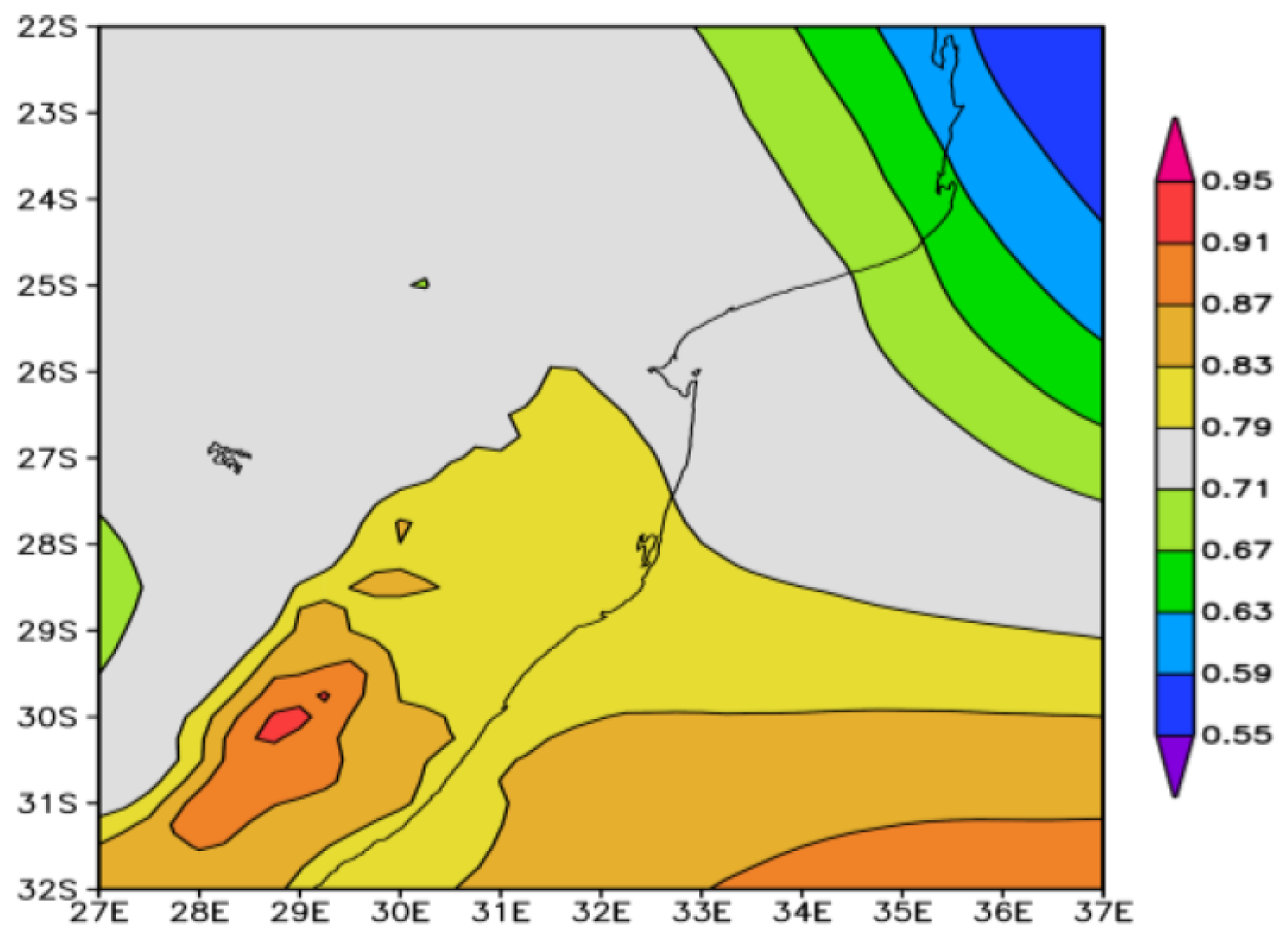
References
- Zhao, Y.; Wen, Z.; Li, X.; Chen, R.; Chen, G. Structure and maintenance mechanisms of the Mascarene High in austral winter. Int. J. Climatol. 2022, 42, 4700–4715. [Google Scholar] [CrossRef]
- Cook, K.H. The South Indian convergence zone and interannual rainfall variability over Southern Africa. J. Clim. 2000, 13, 3789–3804. [Google Scholar] [CrossRef]
- Morioka, Y.; Tozuka, T.; Yamagata, T. Climate variability in the southern Indian Ocean as revealed by self-organizing maps. Clim. Dyn. 2010, 35, 1075–1088. [Google Scholar] [CrossRef]
- Lee, S.; Mechoso, C.R.; Wang, C.; Neelin, J.D. Interhemispheric influence of the northern summer monsoons on southern subtropical anticyclones. J. Clim. 2013, 26, 10193–10204. [Google Scholar] [CrossRef]
- Xulu, N.G.; Chikoore, H.; Bopape, M.-J.; Nethengwe, N.S. Climatology of the Mascarene High and its influence on weather and climate over southern Africa. Climate 2020, 8, 86. [Google Scholar] [CrossRef]
- Jury, M.R. The dry season climate of tropical southern Africa and implications for pyrogenic emissions. S. Afr. J. Sci. 2000, 96, 387–390. [Google Scholar]
- Wang, Y.; Li, K.; Chen, X.; Yang, Z.; Tang, M.; Campos, P.M.D.; Yang, Y.; Yue, X.; Liao, H. Revisiting the high tropospheric ozone over southern Africa: Role of biomass burning and anthropogenic emissions. Atmos. Chem. Phys. 2025, 25, 4455–4475. [Google Scholar]
- Ficchi, A.; Cloke, H.; Neves, C.; Woolnough, S.; de Perez, E.C.; Zsoter, E.; Pinto, I.; Meque, A.; Stephens, E. Beyond El Niño: Unsung climate modes drive African floods. Weather Clim. Extrem. 2021, 33, 100345. [Google Scholar] [CrossRef]
- Cook, K.H.; Liu, Y.; Vizy, E.K. Congo Basin drying associated with poleward shifts of the African thermal lows. Clim. Dyn. 2020, 54, 863–883. [Google Scholar] [CrossRef]
- Engelbrecht, F.A.; Steinkopf, J.; Padavatan, J.; Midgley, G.F. Projections of future climate change in southern Africa and the potential for regional tipping points. In Sustainability of Southern African Ecosystems Under Global Change; Ecological Studies; Springer: Cham, Switzerland, 2024; Volume 248, pp. 169–190. [Google Scholar]
- NESDIS. Vegetation Condition Products Based on NOAA Satellite Radiance. 2021. Available online: https://www.star.nesdis.noaa.gov/smcd/emb/vci/VH/VH-Syst_10ap30.php (accessed on 1 August 2025).
- Lee, H.-T. Climate Algorithm Theoretical Basis Document: Outgoing Longwave Radiation (OLR); NOAA CDR program, ATBD-0526; NOAA: Washington, DC, USA, 2014; 46p. Available online: https://www.ncei.noaa.gov/pub/data/sds/cdr/CDRs/Outgoing%20Longwave%20Radiation%20-%20Daily/AlgorithmDescription_01B-21.pdf (accessed on 1 August 2025).
- Funk, C.; Verdin, A.; Michaelsen, J.; Peterson, P.; Pedreros, D.; Husak, G. CHIRPS: A global satellite-assisted precipitation climatology. Earth Syst. Sci. Data 2015, 7, 275–287. [Google Scholar] [CrossRef]
- Gelaro, R.; McCarty, W.; Suárez, M.J.; Todling, R.; Molod, A.; Takacs, L.; Randles, C.A.; Darmenov, A.; Bosilovich, M.G.; Reichle, R.; et al. The modern-era retrospective analysis for research and applications v2 (Merra2). J. Clim. 2017, 30, 5419–5454. [Google Scholar] [CrossRef] [PubMed]
- Carton, J.A.; Chepurin, G.A. SODA4, a mesoscale ocean-sea ice reanalysis. ESS Open Arch. 2023, 22541, 63382399. [Google Scholar]
- Mo, K.C.; Paegle, J.N. The Pacific–South American modes and their downstream effects. Int. J. Climatol. 2001, 21, 1211–1229. [Google Scholar] [CrossRef]
- Chikoore, H.; Jury, M.R. South African drought, deconstructed. Weather Clim. Extrem. 2021, 33, 100334. [Google Scholar] [CrossRef]
- Manatsa, D.; Morioka, Y.; Behera, S.K.; Matarira, C.H.; Yamagata, T. Impact of Mascarene high variability on the East African short rains. Clim. Dyn. 2014, 42, 1259–1274. [Google Scholar] [CrossRef]

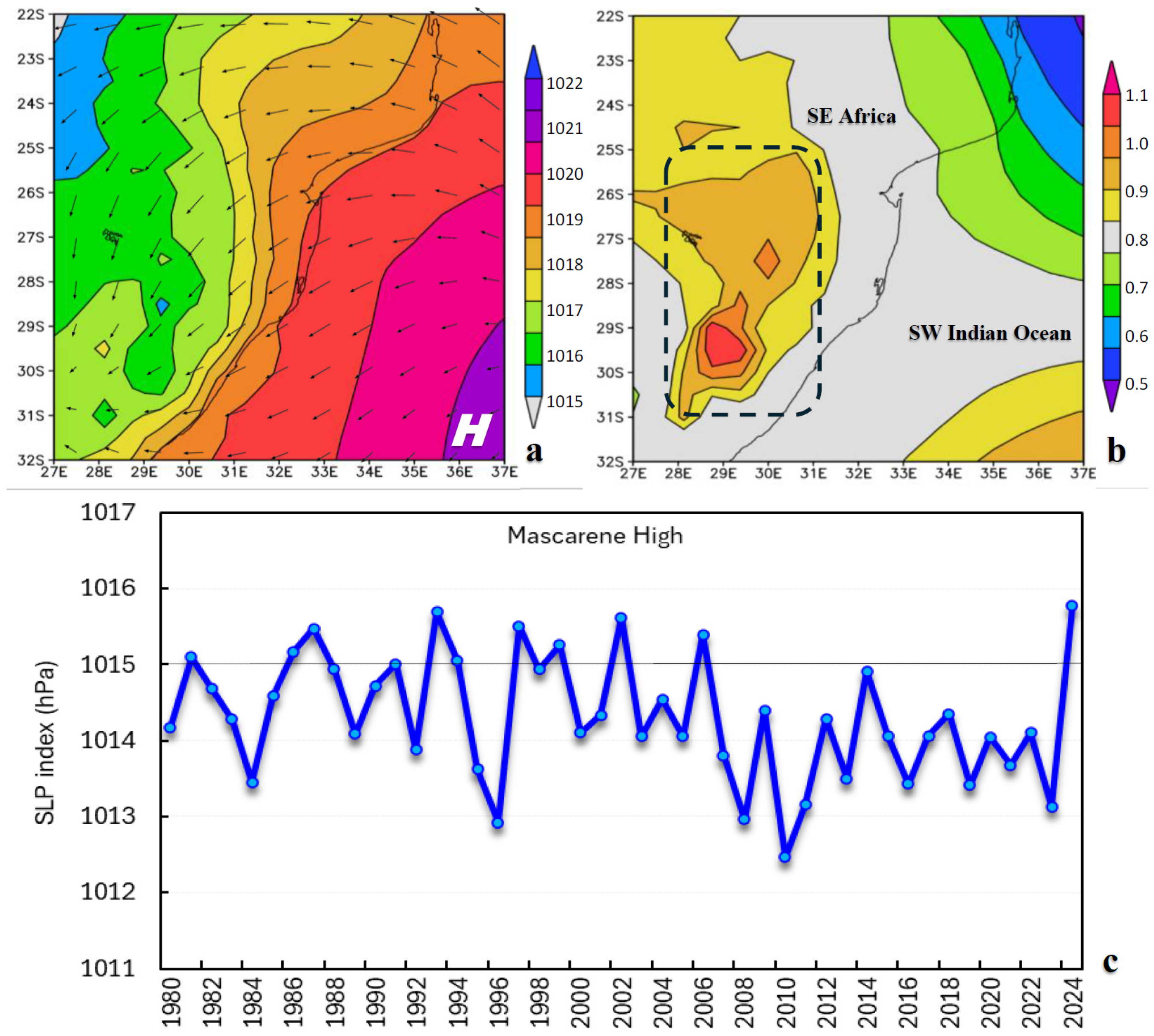
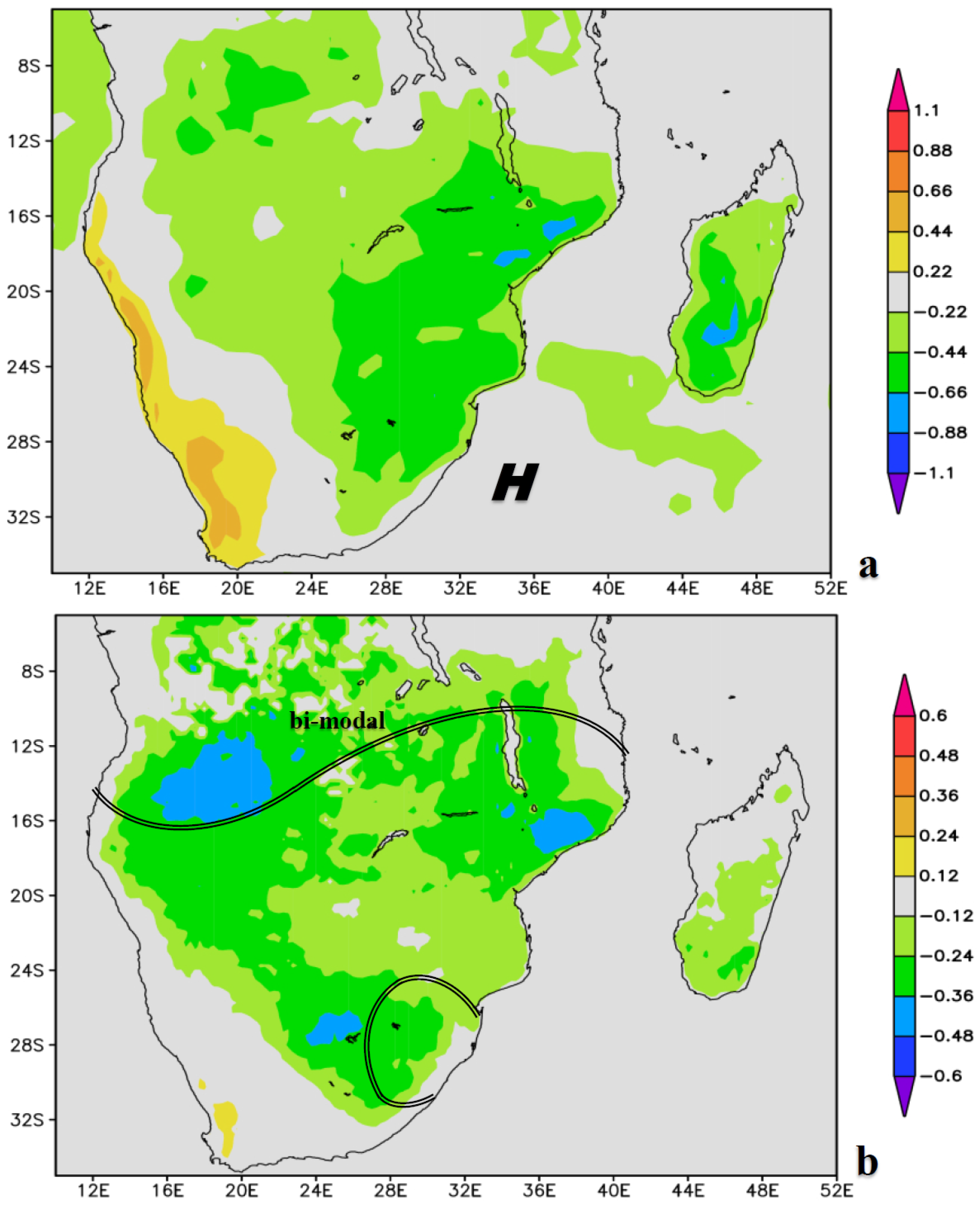


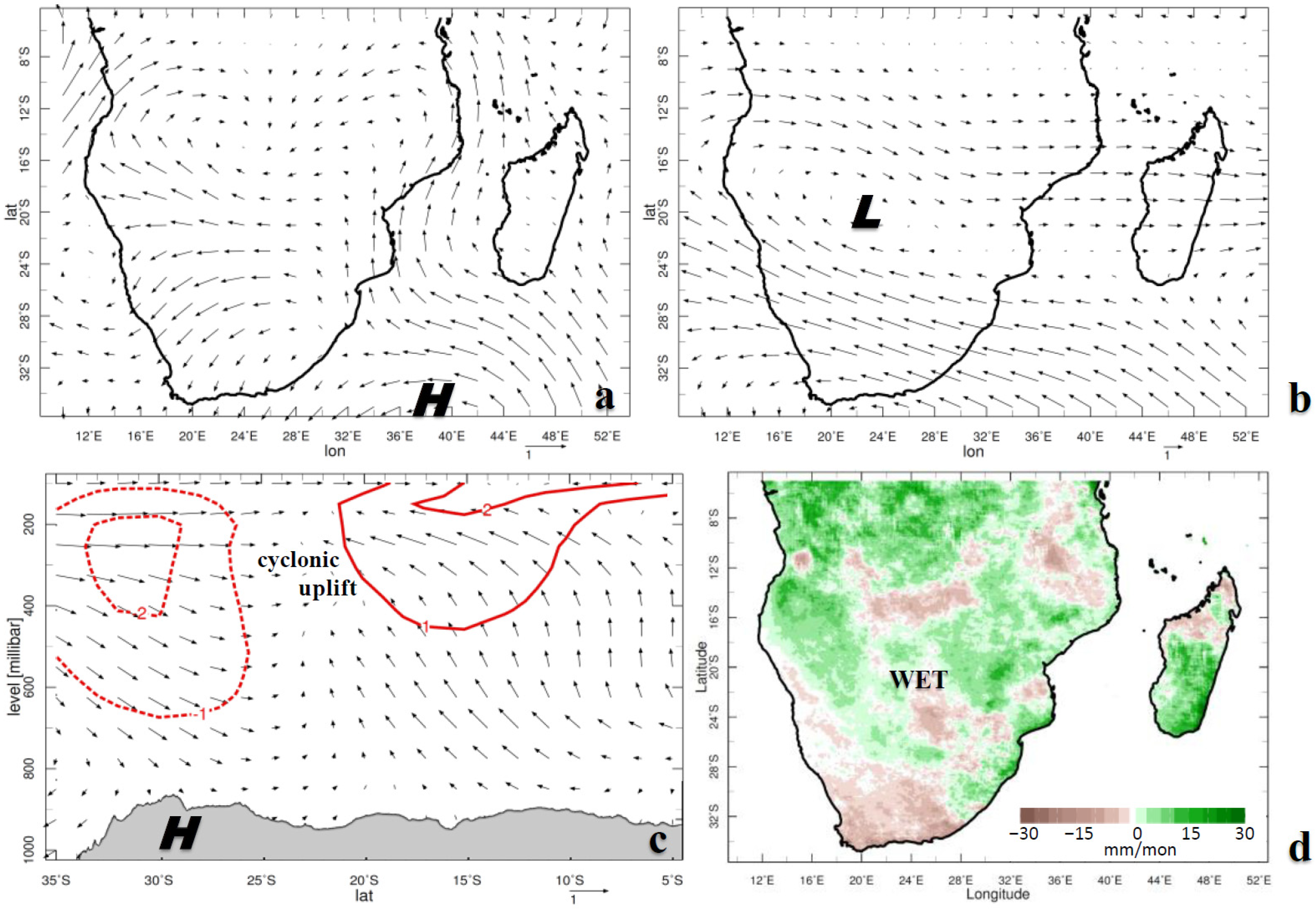
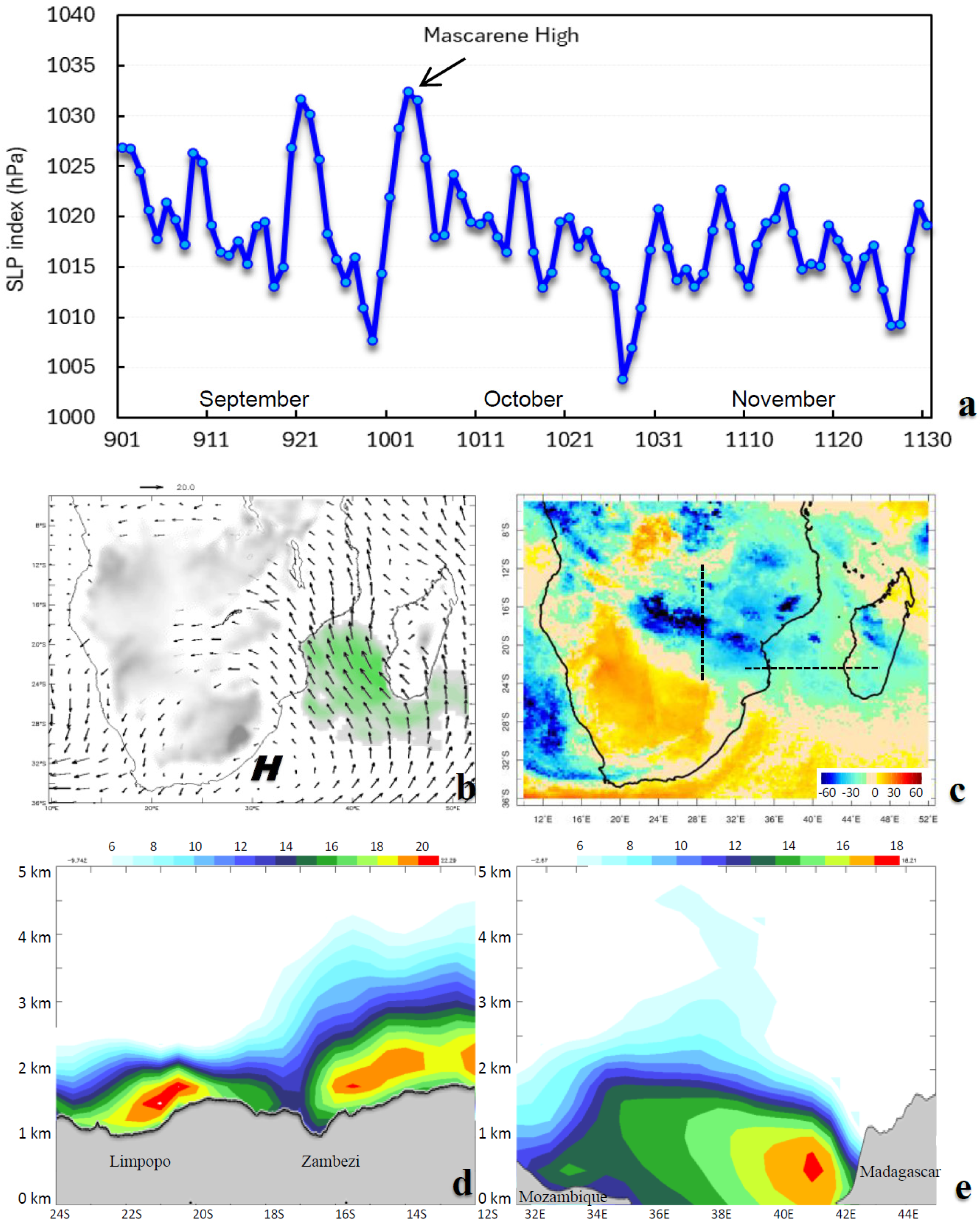
Disclaimer/Publisher’s Note: The statements, opinions and data contained in all publications are solely those of the individual author(s) and contributor(s) and not of MDPI and/or the editor(s). MDPI and/or the editor(s) disclaim responsibility for any injury to people or property resulting from any ideas, methods, instructions or products referred to in the content. |
© 2025 by the author. Licensee MDPI, Basel, Switzerland. This article is an open access article distributed under the terms and conditions of the Creative Commons Attribution (CC BY) license (https://creativecommons.org/licenses/by/4.0/).
Share and Cite
Jury, M.R. Springtime Influence of the Mascarene High over SE Africa: Linking El Niño to Early Rains. Climate 2025, 13, 237. https://doi.org/10.3390/cli13110237
Jury MR. Springtime Influence of the Mascarene High over SE Africa: Linking El Niño to Early Rains. Climate. 2025; 13(11):237. https://doi.org/10.3390/cli13110237
Chicago/Turabian StyleJury, Mark R. 2025. "Springtime Influence of the Mascarene High over SE Africa: Linking El Niño to Early Rains" Climate 13, no. 11: 237. https://doi.org/10.3390/cli13110237
APA StyleJury, M. R. (2025). Springtime Influence of the Mascarene High over SE Africa: Linking El Niño to Early Rains. Climate, 13(11), 237. https://doi.org/10.3390/cli13110237





